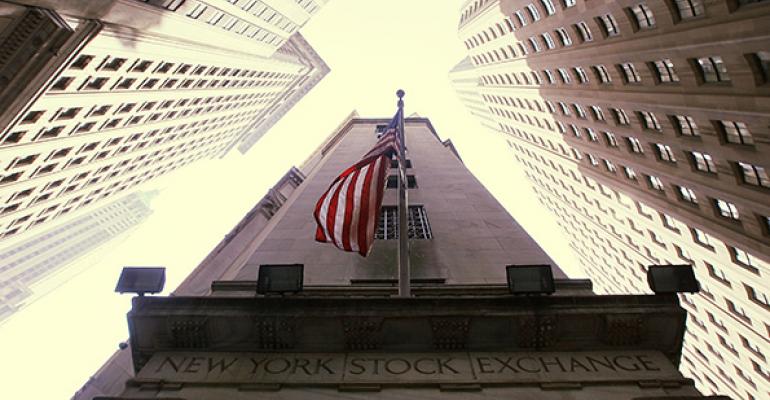(Bloomberg) -- Here’s what happened during the rebound in equities that added nearly $3 trillion to U.S. share values in 10 weeks: mutual funds hoarded cash, short sellers tightened their grip on bearish bets and individuals bailed out of the market.
The divergence between sentiment and prices has been so wide that 2016 is shaping up as the “Year of the Wrong-Way Trade,” beginning with hedge funds that lost the most money in four years betting on momentum stocks. As the S&P 500 soared 15 percent since Feb. 11, investors have all but stopped trading: volume is down 20 percent since the index bottomed.
What should have been a chance for money managers to recover from the worst start to a year on record has instead been a missed opportunity. In many ways, it underscores a pattern that has been repeated since virtually the start of the bull market more than seven years ago -- and to some investors, the reason stocks will keep climbing.
“That skepticism is bullish,” Alec Young, an investment strategist at OppenheimerFunds Inc. in New York, said by phone. “With skepticism, outflows, lightening up into strength -- those types of things tend to support stocks. Whether it’s because stocks don’t go down because there’s a bid or because stocks can move to the upside is debatable, but it’s a bullish influence.”
For fund managers, nothing about 2016’s equity landscape has been welcoming. The S&P 500 fell in four of the year’s first six weeks, losing 11 percent as oil plunged and concern mounted about bank earnings. In the 2 1/2 months since, the index is up in eight of 11 weeks, capping the biggest quarterly rebound on record. The gauge was up 0.4 percent by 10:15 a.m. in New York.
Getting everything right in such a market was next to impossible and just 19 percent of mutual funds beat the S&P 500 in the period, the fewest since at least 1998, research from Bank of America Corp. showed.
“The market has had a very big move and it wasn’t something that benefited most investors,” Tom Lee, managing partner and co-founder of Fundstrat Global Advisors LLC in New York, said by phone. “When stocks make new highs, people will have to come around and get positioned properly.”
So far, the response by investors has been to get defensive. Cash held in funds around the world rose to an average 5.4 percent of assets as of mid-April, according to a Bank of America survey of money managers overseeing a total $493 billion. That’s above the three-year average of 4.8 percent and an increase from the prior month.
Individuals took cover, too. Americans have been net sellers of stocks since 2009 and the latest rally is no exception. Investors pulled a near-record $130 billion from equity funds in the 12 month-period ending March 23, according to data from the Investment Company Institute.
“Investors continue to favor safety and income,” said Michael Arone, the Boston-based chief investment strategist at State Street Global Advisors’ U.S. intermediary business. The firm oversees $2 trillion. “They’re concerned it’s a permanent liquidity provided by central banks that’s pushing the rally forward, and not the underlying fundamentals.”
If bears have one thing working for them, it’s recent history. The S&P 500, which closed Friday at 2,065.3, is within 3.1 percent of its record reached in May 2015, and hasn’t posted a new high for 12 months, the longest stretch since the bull market began. The gauge is also down 2.1 percent over the last year.
“Volumes are down and when customers do come in it’s in incremental moves and not a lot of sector re-allocations or changes to asset allocations,” said Larry Peruzzi, managing director of international equities at Mischler Financial Group Inc. in Boston. “It’s a fragile market.”
Investors pulled $9.5 billion from mutual funds investing in U.S. stocks in March, according to data from the Investment Company Institute. In the first three weeks of April, an additional $12.8 billion was withdrawn from the funds.
“No one’s been clamoring to add more stocks to their account despite the fact it’s been a really great rally,” Bill Stone, chief investment strategist at PNC Wealth Management in Philadelphia, said by phone. “It’s a relatively hated rally. It’s a combination of economic data showing anemic growth in the first quarter, the rest of the globe not looking too pretty, and the whipsaw from earlier in the year.”
One exception is hedge funds, a group of investors who initially reduced holdings and now are slowly returning to the equity market. Hedge funds and large speculators this month raised their stake in S&P 500 index futures to net long for the first time since June.
That doesn’t mean investors have lost all their conviction. Average short interest in U.S.-listed companies reached an eight-year high of 4.3 percent of shares outstanding by Feb. 29, according to exchange data compiled by Bloomberg. As of April 15, the level was 4.1 percent, higher than all but four other twice-monthly readings since 2009.
Even with the benchmark index 3.2 percent from its all-time high, daily trading is dwindling. An average of 7.5 billion shares have changed hands each day on U.S. exchanges since mid-February, down 20 percent from 9.4 billion when the market was tumbling.
While other stock market recoveries the past two years also saw thinner trading on the way up than the way down, the discrepancies were much narrower: volume was no more than 8 percent lower during those rebounds, Bloomberg data show.
“Once we crossed the 2,000 level on the S&P people have been pretty convinced they want to get out of positions and thought, ‘why don’t I lighten up on risk assets?”’ said OppenheimerFunds’ Young.





